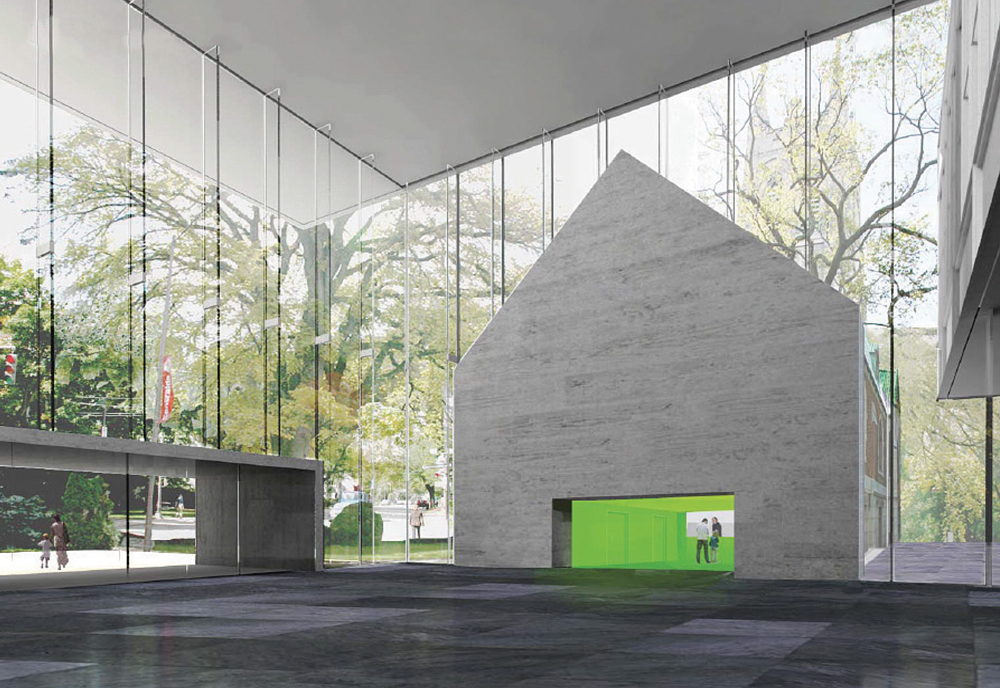Government officials and members of the press gathered in Quebec City this week to preview what is being touted as a new “world-class pavilion” at the Musée National des Beaux-Arts du Québec.
The new 15,000-square-metre pavilion is the first North American museum building designed by the Rotterdam-based Office for Metropolitan Architecture—an outfit famed for its founding by starchitect Rem Koolhaas, as well as its recent award-winning reno for Milan’s Prada Foundation.
“This is what we call an international-quality building,” MNBAQ executive director Line Ouellet tells Canadian Art. “It’s the kind of museum you like to be in in New York or Paris or London.”
The building is still under construction and won’t open to the public until June 24—St-Jean Baptiste Day.
But that Quebec-heritage holiday provides a strong thematic timing for the pavilion’s opening, as it showcases Quebec art from 1960 to the present day. One example is Jean-Paul Riopelle’s massive 40.2-metre-long work Tribute to Rosa Luxembourg (1992), which will be featured in a passageway between the MNBAQ’s old and new pavilions.
“This is a monument for the 21st century in terms of heritage,” Ouellet says. “And it is very exciting because when you are building a new pavilion, it mean as you have more space for the collection. It almost doubles the space [for that].”
The new building also allows for a redeployment of the museum’s collection of Quebec decorative arts and design, and a space to showcase its Inuit art collection.
However, as for many museums, adding a new building offers both challenges and opportunities. The main challenge for many museums is keeping the institution afloat financially following the initial outlay—and then, upkeep—of such a resource.
When asked about how the MNBAQ might respond to such challenges, Ouellet responds, “We are very realistic. All the programming has been done around the collection, and we are not increasing the temporary exhibition space—temporary space is moving to the new pavilion and is more efficient in terms of what is international quality for temporary spaces,” but that’s it.
Ouellet is also emphasizing the positive role the museum addition can play in urban development and local economies—particularly as the cornerstone of Quebec City’s new arts and culture district.
“It’s a way also to look at those extension not only from the museum point of a view, but a city point of view, an economic development point of view, a citizen point of view,” says Ouellet.
Accordingly, the new pavilion is sited very visibly along Quebec City’s Grande Allée, and it has an 250-person auditorium for use by museum partners.
Also, this summer will see the MNBAQ collaborate with playwright Alexandre Fecteau on a opening-weekend open-air market; with local theatre company Les Incomplètes on a work called Home Sweet Home; with EXMURO arts publics on HUMANORIUM, an outdoor public art project in the style of a travelling fairground; and with composers Yannick Plamondon and Symon Henry on what is being dubbed “the very first orchestral work for architecture commissioned by a museum,” Voir dans le vent qui hurle les étoiles rire, et rire.
Funding of $103.4 million was needed for the 21-metre-high, green-roofed building. The provincial government contributed $45.1 million, the federal government, $33.7 million, and the MNBAQ Foundation (private donations), $24.6 million. The largest private donation was $10 million from MNBAQ board chair Pierre Lassonde, for whom the new pavilion is named.
This article was clarified on March 1, 2016. The original article only mentioned composer Yannick Plamondon in relation to the orchestral work being composed for the MNBAQ addition.









